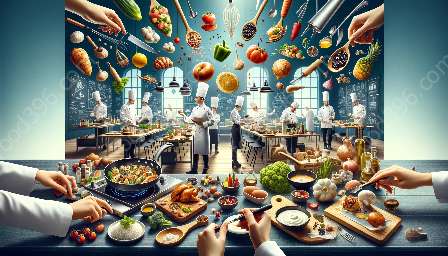Introduction
Molecular gastronomy, an innovative and avant-garde culinary approach, has revolutionized the world of food and cookery. At its core, it is a scientific discipline that explores the transformation of ingredients and textures through modern scientific techniques. Encompassing a world of creative possibilities, molecular gastronomy techniques have captivated the culinary world and continue to inspire chefs and food enthusiasts alike. In this guide, we will delve into the intricacies of molecular gastronomy, its compatibility with traditional culinary techniques, and its importance in culinary training.
Understanding Molecular Gastronomy
Molecular gastronomy is a culinary movement that combines scientific principles with culinary arts to explore and experiment with the physical and chemical transformations of ingredients. It focuses on understanding the behavior of ingredients and their interactions at a molecular level. Through the application of techniques such as spherification, gelification, emulsification, and foaming, chefs can create visually stunning and palate-pleasing dishes that defy traditional norms.
Techniques in Molecular Gastronomy
1. Spherification: Spherification involves the creation of small spheres or caviar-like droplets using sodium alginate and calcium chloride to encapsulate flavors and textures within a delicate membrane.
2. Gelification: Gelification transforms liquids into gels using gelling agents such as agar-agar and gellan gum, allowing chefs to manipulate textures and create unique presentations.
3. Emulsification: Emulsification techniques enable the creation of stable emulsions, resulting in creamy and smooth textures that enhance the overall dining experience.
4. Foaming: By incorporating gases into liquids using devices such as nitrous oxide chargers, foaming allows chefs to create luxurious and airy textures in both sweet and savory dishes.
Integration with Culinary Techniques
Molecular gastronomy techniques complement traditional culinary methods by providing chefs with a new palette of tools to express their creativity. The fusion of molecular gastronomy and classical culinary techniques allows for the elevation of flavors, textures, and presentations, offering diners a multi-sensory experience that transcends expectations.
Additionally, chefs trained in traditional culinary arts can expand their skill set by integrating molecular gastronomy techniques, adding a modern twist to their repertoire while maintaining a strong foundation in traditional cooking methods.
Relevance to Culinary Training
As the culinary landscape continues to evolve, the incorporation of molecular gastronomy into culinary training programs has become increasingly important. By introducing aspiring chefs to the principles and techniques of molecular gastronomy, culinary schools are equipping students with the knowledge and creativity to navigate the ever-changing gastronomic industry.
Students can learn to apply scientific concepts to food preparation, experiment with cutting-edge techniques, and understand the impact of molecular gastronomy on the sensory experience of diners. This comprehensive approach to culinary training prepares students to embrace innovation and adapt to emerging trends in the culinary world.
Conclusion
Molecular gastronomy techniques have ushered in a new era of culinary exploration, challenging traditional norms and inspiring a wave of creativity among chefs and food enthusiasts. As the boundaries between science and art blur, molecular gastronomy continues to enrich the culinary landscape, offering a captivating fusion of innovation and tradition. By embracing the principles of molecular gastronomy and integrating them into culinary training, the next generation of chefs will undoubtedly shape the future of gastronomy with their boundless creativity and technical mastery.

